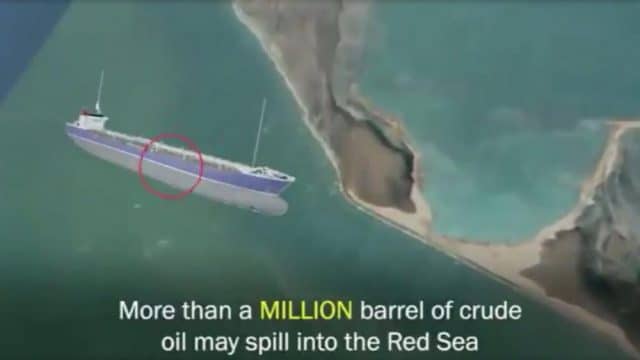
A stranded tanker loaded with oil off the coast of Yemen is threatening a massive environmental disaster in the Red Sea with experts describing the situation as a “floating bomb”.
The Safer tanker, owned by Yemen’s biggest oil company, has been moored some 7km off the Yemeni port of Ras Isa, in the north-west of the country, for decades, where it was being used as a floating storage and offloading terminal.
But it has been left unmaintained since 2015 when the civil war between the Iran-backed Houthi rebels and the government — supported by Saudi Arabia and the United Arab Emirates — began, according to the United Nations.
Mark Lowcock, the UN’s undersecretary-general for humanitarian affairs, told the UN Security Council last week that an assessment team had been denied the necessary permits by Houthi rebels who control the area.
“I would just like to note that this is additionally frustrating when one recalls that the same authorities wrote to the United Nations early last year requesting assistance with the tanker and promising to facilitate our work,” he said.
Inert gas
Fears are that the tanker could explode as its boilers have stopped producing inert gas.
Inert gas — which contains insufficient oxygen to suppress combustion — is used to fill in the void above the oil in the storage tanks, according to the Conflict and Environment Observatory (COE).
A blast or a leak could lead to the tanker’s estimated 1.1 million barrels of oil to spill into the Red Sea.
“Depending on the time of the year and water currents, the spill could reach from Bab el Mandeb (a strait leading to the Gulf of Aden, south of Ras Isa) to the Suez Canal (north of the tanker, in Egypt) — and potentially as far as the Strait of Hormuz (between the UAE and Iran),” Lowcock warned last month.
“I leave it to you to imagine the effect such a disaster on the environment, shipping lanes and the global economy,” he went on.
Environment and economy
In a video posted on social media last week, Yemen’s UN-recognised government said the environmental disaster would be four times greater than the 1989 Exxon Valdez Oil spill in which 260,000 barrels of oil were spilt in Alaskan waters in what is considered to be the worst man-made environmental disaster in history.
This would severely impact communities reliant on fishing in the countries surrounding the Red Sea including Egypt, Eritrea, Israel, Saudi Arabia, Sudan and Yemen as well as the marine life.
“While the Exxon Valdez discharged its oil into the cold waters off Alaska, where the breakdown of oil would be slower than in the warm waters of the Red Sea, Ras Isa is close to one of Yemen’s few Marine Protected Areas off nearby Kamaran Island, whose mangroves and coral reefs support local fisheries,” Doug Weir, from the COE, noted in a blog post in May.
“A major spill would invariably overwhelm Yemen’s domestic pollution response capacity, and be complicated by the naval security issues in the Red Sea,” he also flagged.
The impact on the global economy could also be severe. A study by an Italian research organisation, SRM, estimated that 9% of the world’s oil shipments travelled through the Suez Canal in 2018.
The US Energy Information Administration also estimated that 4.8 million barrels of refined petroleum products shipped daily through the Bab el-Mandeb Strait in 2016 out of nearly 59 million. Meanwhile, nearly a third of oil products sail down the Strait of Hormuz.
The Houthi authorities and Yemen’s UN-recognised government dispute who should receive the proceed from the crude oil on board the Safer — estimated at than $60 million (€53.8 million).







